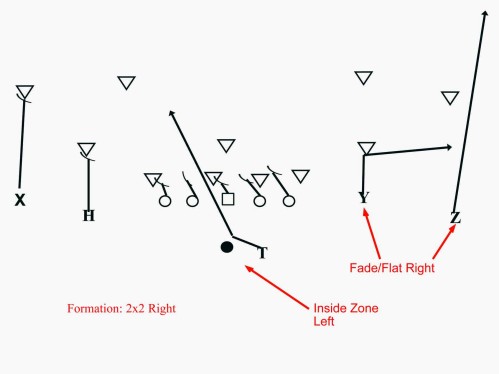Packaging Plays Part I Introduction to Packaging
by Rich Hargitt
Assistant Head Coach and Offensive Coordinator • Ashbrook High School (NC)
Packaging plays can not only ignite an offense but also confuse a defense.
All offensive play callers strive to make the perfect call on Friday nights and want to be right on every snap. Unfortunately, defenses make this tremendously difficult to do because they are able to adjust coverages, stunts, and fronts relatively easily and then put themselves in a great position to stop an opposing offense.
The idea of packaging plays together grew out of a necessity to counter the defense’s countermeasures. The game of football is, after all, an evolving art and science of elaborate chess moves involving human pieces. Play callers on both sides of the field are constantly attempting to find the correct answers for a play and adjust to the adjustments that their opponent might be trying to make. An offensive coach can utilize packaged plays to get his team into an advantageous position regardless of what the defense is doing. For instance, if a running play is packaged with a quick screen, the play caller has the ability to decide pre-snap which concept more favorably attacks the defense. This ability to adjust at the last moment can be controlled from the sideline and responsibility can be given to the quarterback on the field to make that decision. Either way, the ability to change from one play to the next at the final moment before the snap gives the offense an advantage.
The packaged play is most effective when the entire offense is involved in the deception. Therefore, it is preferable that the two plays are called together and then the offense is told to execute both plays simultaneously.

The diagram shows the offense operating from a base 2 x 2 set and the play called is the Inside Zone but it is packaged with a Fade/Flat Quick Pass Concept to the perimeter. The package is signaled in with two hand signals and the offense then executes both plays simultaneously. Therefore, the defense will not know which play the quarterback actually intends to execute until it is too late.
The offense is creating a deceptive situation for the defense that will make it very difficult for them to read keys. As an example, if the defense is reading the blocks of the offensive linemen, they will see a run play but the ball may be thrown to the flat. The quarterback must execute a quick throw to prevent an illegal man downfield call but often the ball is coming out of the backfield so quickly that this is not an issue. Once a team commits to creating these sorts of packages, the sky is the limit in terms of what sorts of offensive mutations can result. These packaged concepts allow the offense flexibility in getting into the correct call pre-snap but also, because they are executed simultaneously, serve to confuse and disorient the defense after the snap as well.
A play caller could utilize a wide variety of play types packaged together. Each team will, of course, decide which concepts, when packaged together, gives them a decided advantage over their opponents. Some of the packages utilized at Ashbrook High School (NC) include:
• Run play packaged with a quick screen or pass.
• Slow screen packaged with a quick screen.
• Slow screen packaged with a slow screen.
• Drop back pass packaged with a drop back pass.
• Drop back pass packaged with a quick pass.
• Quick pass packaged with a quick pass.
These concepts are certainly not all encompassing but they provide an example of how much room for growth and exploration there is in the world of packaging concepts together. This idea has grown and continues to develop around the country as offensive play callers realize that packaged concepts give them increased flexibility and control over the game. In Part II of this series, we will discuss “Packaging Run Plays with Quick Passes and Screens From a Variety of Formations.”
About the Author: Rich Hargitt is the assistant head coach and OC for Ashbrook High School in Gastonia, North Carolina. He is a frequent contributor to both American Football Monthly and Gridiron Strategies and currently has a series of offensive DVDs available at www.AFMvideos.com.
Girdiron Strategies
P.O. Box 14007
North Palm Beach, FL 33407
1-800-527-4271 option 4